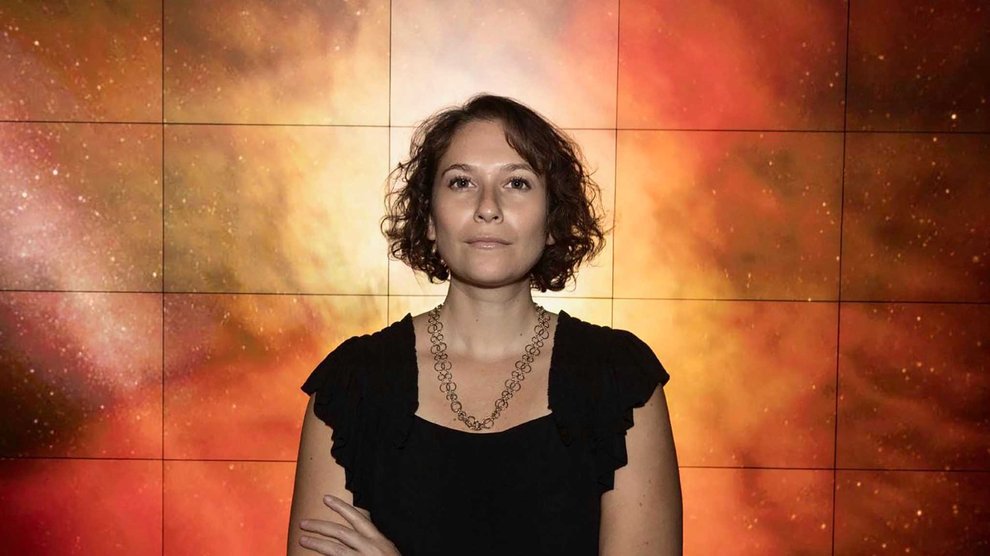Searching for Life Beyond Earth, Finding Our Dreams Instead
Our search for life beyond Earth is more than scientific—it’s a quest to find our perfect selves.

How would you recognize another Earth while you’re on this one?
That’s a question astronomers often try to answer. Oh, the scientists say, they could look at orbital models, temperature models, atmospheric models, formation models. All kinds of models. “None of these models include anything like pollution or warfare or any of the things that make Earth a human world,” says Lisa Messeri, an anthropologist of science and technology. There was a striving quality to their answers.
“We don’t want to find a world with warfare or stricken with poverty,” Messeri says. We want a perfect world, she continues, “a world that is untouched by human activity.”
Messeri herself doesn’t study these great-beyond planets: She studies the people who study them. And in their presentations, papers, and talk amongst themselves Messeri notices a few things: that the astronomers have turned these light-years-away planets into real places—not just plots and pixels—defined in comparison and contrast to this terra firma. Most importantly, though, Messeri sees evidence that while exoplanet science is a field of the present and future, it also reaches, fundamentally, toward the past.
The astronomers Messeri studies often spend their lives searching for so-called Earth-like planets. These worlds could potentially have life. They could have liquid water or continents or oxygenated air. They’re the right sizes at the right distances from their suns, and could have the right atmospheres and oceans. We sometimes call this search one for “Earth’s twin.”
But that’s not quite right, Messeri says: It’s actually the search for Earth’s perfect twin. Earth as it used to be, before humans got to it. A whole-world Eden.
Yearning for Home
After attending a meeting of Kepler space telescope scientists, Messeri read more about the philosophical concept of home, she says, “and what a home is and this idea of ‘Can you ever go back to your home?’ ” She had first picked up this thread in graduate school, and now she returned to work from mid-20th-century philosophers, who’d grown up before World War II and had to continue living after it. They missed their prelapsarian place.
And, Messeri realized, exoplanet astronomers felt that same feeling—for a place that they’d never known: an Earth without them.
There’s a word that conveys that feeling, actually, in Welsh: hiraeth, longing for a home you’ve never had or can’t return to.
Finding Herself
“Anthropologist” wasn’t a thing Messeri initially intended to become. At MIT as an undergrad, she was poised to enter the workforce as an aerospace engineer. She loved space: the existence of it, the bigness of it, the big questions it forced you to try to answer whether you wanted to or not. “But by the time I got to my senior year, I began to realize that the actual day-to-day work of an engineer wasn’t something I was particularly enamored of,” Messeri says. Expanding her interests, she took an elective course about the history of science. The idea that science had a history—that it came from somewhere and had not always been thus—had never exactly occurred to her.

But she liked the idea so much that she went on to get a doctorate in the history and anthropology of science and technology. When it came time to pick a dissertation project, she went back to what had first caught her scientific interest: all that stuff beyond our atmosphere, all the people who tried to figure it out. Messeri’s roommate was a planetary scientist and offered to introduce her to some people in her department—people who included Sara Seager, who, back in 2008, wasn’t yet the rock star she is now and hadn’t yet been profiled by CNN or the New York Times. So Messeri began to (with permission) follow these exoplanetary scientists around—watching them code, watching them use telescopes, watching them make sense of the dots and lines decorating x-y axes.
Finding Places We’ve Never Been
Messeri’s scrutiny of these scientists came to focus on placemaking. It’s not a gerund we think about often: transforming a position in x-y-z-t space into something with more sentiment happens seemingly automatically in our minds.
But while it’s normal for humans to do that, it still takes mental work. “Places don’t just exist,” Messeri says. “We have to make them.” Each place is tinted by our particular history, our sensory interpretations, our social contexts. In just about every case, we placemake in places where we’ve visited or lived or of which we’ve seen copious Street Views. “But can there be places,” Messeri wondered, “that are not on Earth, where humans haven’t been?”
It seemed to her that the exoplanet astronomers thought so. They had transformed their planets into places, seeing each of them as a small step on the way toward the real goal: that perfect place, the never-inhabited-by-humans habitable home.
Seeking a Perfect Species
But those homes may not be uninhabited—they potentially may be someone else’s planet. That thought frames the work of SETI scientists, another group of researchers who are looking not just for habitable worlds or for the chemical signatures of biology, but for smart, technologically capable inhabitants. In their quest for advanced civilizations, these SETI—search for extraterrestrial intelligence—scientists bring their own idealizations to their quest. They are usually scouring the universe for a type of species we hope to become: nonviolent and stable, the kind that sticks around long enough to broadcast signals that lesser beings like us might pick up.
Their field began around 1960 and solidified around a conference at the National Radio Astronomy Observatory in Green Bank, West Virginia. There, a young astronomer named Frank Drake came up with “the Drake Equation,” which gives researchers a framework for talking about how many intelligent civilizations might inhabit the Milky Way galaxy. Drake’s formula steps through the conditions required for life to arise and gain intelligence: First comes the rate at which suitable stars form ( R ), followed by the fraction of those suitable stars that have planets ( f*p ). Then, one must consider the number of planets around those stars that are “habitable” ( n*e ), the fraction of those habitable planets on which life arises ( f*l ), the fraction of those life-having planets on which the life becomes intelligent ( f*i ), and the fraction of those intelligent civilizations that use technology to send signals to space ( f*c ).
Some of those variables are straight physics: questions that have easy answers, albeit ones we don’t fully understand yet. The evolution of actual life and serious smarts and the development of detectable technology are less quantified and perhaps less quantifiable.

But there’s one more variable in the equation—and it could be the biggest question-mark factor determining whether we can find alien life. Scientists call it L : the length of time that intelligent civilizations keep broadcasting.
What L actually connotes is “the amount of time a technological society usually stays around before it destroys itself or significantly regresses.” If L is small, it could mean humans are the only ones in reasonable shouting distance. If it’s large, there could be many more intelligent others out there.
Humans are the only example of intelligent life that we have. So L , based on our personal stats (and because we could blow ourselves up tomorrow and stop broadcasting signals into space), is on the order of 100 years—the approximate amount of time we’ve been producing radio transmissions. Of course, we could stick around and stay smart for a lot longer and prove that conservative estimate of our own L wrong.
But if SETI finds anything (or anyone), those aliens likely will have been around for a long time (the chances that we’d find aliens that had popped up just 50 years ago is smaller than minuscule). That means any intelligent alien civilization alien civilization would probably have an L much longer than 100 years. And that would, SETI scientists have long said, give humans hope: In addition to knowing we’re not alone, we’d also suspect that however we’ve changed our planet, whatever marks we’ve left on it and each other, we could figure out how to continue existing. Those aliens figured out how, after all—and they’re aliens!
Finding extraterrestrial intelligence would show us an ideal version of our future selves.
As researcher David Duner, a professor of the history of science and ideas at Lund University, put it in a recent paper, such a civilization must have encountered difficulties like the ones that face us today. “Wars, climate change, pollution, decreasing biodiversity, and so on,” he wrote. “The mere fact that they have survived would indicate that they have a functioning social structure that can handle and avoid crises (or at least that they are able to recover from them), and that they have a complex social system that regulates risks and destructive behavior.” Finding extraterrestrial intelligence, in other words, would show us an ideal version of our future selves—a more cohesive society, one that’s better at stewarding its planet and less murderous of each other.
To search for such a civilization indicates a hope that those versions of intelligence are out there, stably surfing through the universe. These beings may not have kept their Earth-twin planet pristine. Neither would it be that Ur-Earth for which astronomers feel hiraeth. But it would be a place—a real place—that would look nice on a poster. “It may not be perfect,” these ideal aliens may beam in a message to us, “but it will always be home.”
Missing an Imagined Planet
Just as American states have tourism offices and ad campaigns, touting their lush landscapes and theme parks, NASA has an “Exoplanet Travel Bureau.” On its website, you can click to twist and turn around the foreign (illustrated, imagined) surfaces of other worlds, or you can download a promotional poster that portrays these orbs as vacation destinations. There’s the double-starred planet Kepler 16-b, “where your shadow always has company.” Or Kepler 186-f, “where the grass is always redder,” because it orbits a red-dwarf star whose longer-wavelength light may have influenced photosynthesis. On PSO J318.5-22, “the night life never ends”—because it travels through space starless. On huge HD 40307g, meanwhile, you can “experience the gravity of a super earth.”

The posters are done up in the vintage 1930s style of Works Progress Administration advertisements—the Bauhaus-inspired, dreamy types that people now hang framed in their hip houses. Those creations encouraged contemporaries to “See America.” NASA, though, wants the viewer to see something else entirely: planets they can never actually visit. The agency’s posters show a two-shadowed solo pioneer facing a frontier; a person in front of a white picket fence, fronting red foliage; a formally dressed and handsy couple at a late-night social event; and a person skydiving toward a planetary surface.
Exoplanet astronomers almost always put these posters in their public-presentation PowerPoints, Messeri says. Here’s what it might be like if we could go to the places we study, the images convey. Fun!
We humans miss that perfect place, creating a bizarro nostalgia that tinges the science, and the artistic representations from the Exoplanet Travel Bureau: the vintage style, the long-gone American-dream fence, the couple that’s happier and having more fun than we are right now. These posters, these planets, present us with the idea that although an Edenic and unspoiled life isn’t possible on Earth anymore, it could perhaps exist somewhere else—a somewhere else for which we’re homesick.
“What does it mean to be nostalgic for something we haven’t discovered yet?” Messeri asks. “To long for a sense of home in a place that’s not our own planet?”
Image credits: Dan Addison/University of Virginia, NASA/JPL
Video credit: Conceptual Image Lab/Goddard Space Flight Center/NASA



